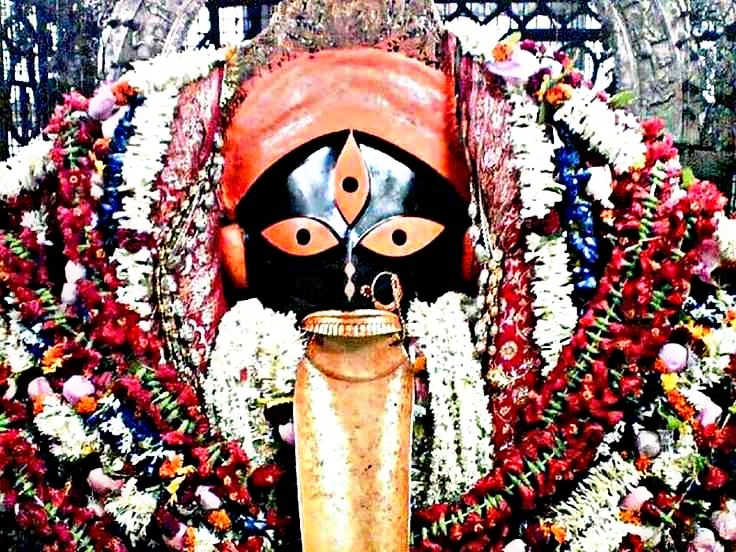
About Kalighat Temple Kolkata
- Kalighat Kali Temple is a Hindu temple dedicated to Hindu goddess Kali, located in Kalighat, Kolkata, West Bengal, India. The temple is dedicated to the Goddess Kali and is considered as one of Indias 51 shakti peethas. The Deity of Kali at the Kalighat temple is unique in that she was not designed following the usual patterns of the other images of Goddess Kali of Hinduism.
Kalighat Kali Temple Kolkata Entry Fee
There is no entry fees for taking the darshan of Kalighat Kali Temple Kolkata.
Kalighat Kali Temple Kolkata Timings

Kalighat Temple History
- It is said that Kalighat Kali Temple was founded by a holy man, Kuranga Giri (after whom Kolkatas Choringhee district is named), who discovered the impression of the face of Kali, and built the initial temple of Kali inside a small cottage. Kalighat is also associated with worship offered to Hindu Goddess Kali by a Dasanami monk named Chowranga Giri, and it is said that the Chowringhee area of Kolkata is named after him. Kalighat is a ghat (landing stage) dedicated to the Hindu goddess Kali, in the Old Course (Adi Ganga) of Hooghly River (Bhagirathi) in the city of Calcutta.
Story of Kalighat Temple Kolkata
- Located in the Old Course of Hooghly river, the Kali temple at Kalighat is considered as one of Indias most famous temples of Kali, and is amongst the most popular places to visit in a tour to Kolkata. Kalighat Kali Temple is considered to be one of 51 Shakti Peethas in India, which is said to be the site where different parts of the Satis body fell, during Shivas Rudra Tandava. According to popular belief, the Kalighat Kali Temple of Kolkata is where one of the parts of Satis body, the Satis,
is believed to have fallen. - It is believed that the right toe of Sati fell there, and later; the Kalighat temple in Kolkata was built in honour of the goddess Kali. The spot where the toe of the right leg of Goddess Sati fell is believed to be the spot on which Kalighat temple is now located. The Kalighat temple of Kali is said to be located on the exact site of where one of the parts of Satis body fell as Lord Vishnu broke up her body into 51 pieces. Kalighat temple, in Kolkata, is situated on the banks of the Hooghly river, and has a sacred shrine, along with an enormous hall called Nat Mandir.
How to Reach Kalighat Temple Kolkata
- By Air – If you are going by air then you have to arrive at Netaji Subhas Chandra Bose International Airport. From airport the temple is 12 km. far. You can easily take bus from there.
- By Train – If you are going by train you have to arrive at Shalimar Railway Station. From Pathankot it is 5 km. far. You can easily opt bus, cab or auto for the mandir.
- By Road– Kalighat Kali Temple Kolkata is well connected by road. Everyone can easily reach here.
Q/A
Q: What is the historical background of Kalighat Temple in Kolkata?
Ans: The Kalighat Temple in Kolkata has a rich historical background, dating back several centuries. It is believed to be one of the oldest Kali temples in the city, with origins rooted in Hindu mythology.
Q: Who is the presiding deity of Kalighat Temple, and what is the significance of Goddess Kali in this context?
Ans: The presiding deity of Kalighat Temple is Goddess Kali, a powerful and fierce manifestation of the Divine Mother in Hinduism. Devotees believe in her protective and nurturing qualities.
Q: Can you describe the architectural features of Kalighat Temple in Kolkata?
Ans: The architecture of Kalighat Temple is characterized by its traditional Bengali style. The temple complex includes a sanctum sanctorum, a courtyard, and various shrines. The main temple structure showcases intricate carvings and artwork.
Q: What are the major festivals celebrated at Kalighat Temple, and how are they observed?
Ans: Kalighat Temple observes several festivals, with Kali Puja being the most prominent. During festivals, the temple sees a surge in devotees who participate in special rituals, prayers, and cultural events.
Q: Are there any unique customs or traditions associated with worship at Kalighat Temple?
Ans: Devotees often engage in unique customs such as offering red hibiscus flowers, vermilion, and sweets to Goddess Kali. The temple priests play a crucial role in guiding devotees through these rituals.
Q: How does Kalighat Temple contribute to the cultural and religious life of Kolkata?
Ans: Kalighat Temple holds immense cultural and religious significance, serving as a focal point for spiritual activities and a place of pilgrimage for devotees from Kolkata and beyond.
Q: What are the visiting hours and any specific guidelines for visitors at Kalighat Temple?
Ans: Kalighat Temple typically opens early in the morning and remains accessible till late evening. Visitors are expected to follow temple etiquette, remove footwear before entering, and maintain a respectful demeanor.
Q: Can you share any legends or mythological stories associated with the founding of Kalighat Temple?
Ans: One popular legend links the temple’s origin to the toes of Goddess Sati falling at the spot where the temple now stands. The temple has since become a sacred site dedicated to Goddess Kali.
Q: How has Kalighat Temple adapted to modern times, and what efforts are in place for its preservation?
Ans: The temple has adapted to modern times by incorporating improved facilities for devotees. Preservation efforts include regular maintenance, restoration projects, and community involvement to ensure the temple’s longevity.
Q: How does Kalighat Temple contribute to the socio-economic fabric of the surrounding community?
Ans: The temple plays a role in the socio-economic aspects by generating local employment opportunities, fostering cultural events, and contributing to the overall spiritual well-being of the community.


